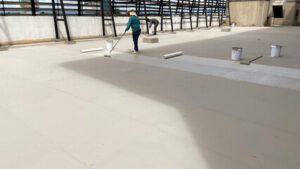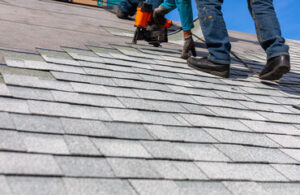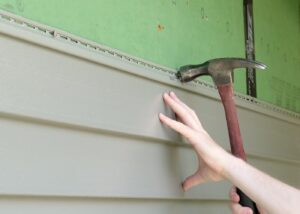Flat roofs are a common feature in modern architecture, prized for their sleek appearance, space-saving design, and versatility. However, flat roofs also present unique challenges regarding maintenance and protection against the elements. Flat roof coating is a critical line of defense, safeguarding these surfaces from water damage, UV exposure, and structural deterioration.

Flat roof coating, also known as roof sealant or roof membrane, is a protective layer applied to the surface of flat or low-slope roofs to enhance durability, waterproofing, and weather resistance. These coatings are typically formulated from elastomeric materials such as acrylics, silicones, polyurethanes, or bitumens, which provide flexibility, adhesion, and UV resistance. Flat roof coatings are available in various formulations, including liquid-applied, spray, and roll-on coatings, each offering unique advantages and suitability for different roofing substrates. Visit wecoatus.com to learn more.
Benefits of Flat Roof Coating
- Waterproofing: One of the primary benefits of flat roof coating is its ability to provide a seamless, waterproof barrier that protects the underlying roof substrate from water infiltration and moisture damage. By sealing cracks, seams, and penetrations, roof coatings prevent leaks and extend the lifespan of the roof.
- UV Protection: Flat roof coatings contain UV-resistant additives that shield the roof surface from the damaging effects of ultraviolet radiation, including color fading, surface degradation, and premature aging. UV protection helps maintain the structural integrity and appearance of the roof, prolonging its service life.
- Energy Efficiency: Reflective flat roof coatings, also known as cool roof coatings, help reduce solar heat gain by reflecting sunlight and heat away from the building. By minimizing heat absorption, cool roof coatings can lower indoor temperatures, reduce air conditioning costs, and enhance energy efficiency.
- Seamless Application: Unlike traditional roofing materials such as shingles or tiles, flat roof coatings are applied in liquid form and cure to form a seamless, monolithic membrane. This eliminates the need for overlapping seams or joints, reducing the risk of water infiltration and improving overall roof performance.
- Cost-Effectiveness: Flat roof coating is a cost-effective solution for extending the lifespan of flat or low-slope roofs without the need for costly roof replacement. By reinforcing existing roofing materials and preventing premature deterioration, roof coatings help minimize maintenance expenses and preserve the value of the property.
Types of Flat Roof Coatings
- Acrylic Coatings: Acrylic roof coatings are water-based formulations that offer excellent adhesion, flexibility, and UV resistance. These coatings are easy to apply, dry quickly, and provide durable protection against the elements. Acrylic coatings are suitable for a wide range of roofing substrates, including metal, concrete, asphalt, and single-ply membranes.
- Silicone Coatings: Silicone roof coatings are highly durable, weather-resistant, and resistant to UV degradation. These coatings form a breathable, waterproof membrane that allows moisture vapor to escape while preventing water penetration. Silicone coatings are ideal for flat roofs exposed to harsh environmental conditions, including extreme temperatures and UV exposure.
- Polyurethane Coatings: Polyurethane roof coatings offer exceptional strength, adhesion, and chemical resistance, making them ideal for high-traffic or industrial applications. These coatings are resistant to abrasion, impact, and punctures, providing long-lasting protection against wear and tear. Polyurethane coatings are commonly used on flat roofs with heavy foot traffic or mechanical equipment.
- Bituminous Coatings: Bituminous roof coatings, also known as asphalt or tar-based coatings, are formulated from bitumen, a byproduct of petroleum refining. These coatings provide excellent waterproofing properties and are resistant to UV degradation, making them suitable for flat roofs in harsh climates. Bituminous coatings are typically applied in multiple layers and may require reinforcement with fabric or membrane materials.
- Reflective Coatings: Reflective roof coatings, also known as cool roof coatings, are designed to reflect sunlight and heat away from the building, reducing the temperature of the roof surface and lowering cooling costs. These coatings are formulated with reflective pigments or additives that enhance solar reflectance and thermal emittance. Reflective coatings are available in various formulations, including acrylic, silicone, and elastomeric coatings.
Application Methods
Flat roof coatings can be applied using various methods, depending on the type of coating and the condition of the roof substrate:
- Spray Application: Spray application is a common method for applying liquid-applied roof coatings, particularly acrylic and silicone formulations. Airless sprayers or pneumatic sprayers are used to apply the coating evenly across the roof surface, ensuring uniform coverage and thickness.
- Roller Application: Roller application is well-suited for applying flat roof coatings to smaller or irregularly shaped roof surfaces. A paint roller or brush is used to apply the coating in overlapping strokes, ensuring thorough coverage and adhesion.
- Brush Application: Brush application is ideal for spot treatments, repairs, or areas with limited access where rollers or sprayers cannot reach. A paintbrush or applicator brush is used to apply the coating to specific areas, seams, or penetrations, ensuring precise application and sealing.
- Trowel Application: Trowel application is commonly used for applying thick or viscous coatings, such as polyurethane or bituminous coatings. A trowel or squeegee is used to spread the coating evenly across the roof surface, ensuring uniform coverage and thickness.
- Professional Installation: For larger or more complex roofing projects, professional installation by trained roofing contractors is recommended. Professional installers have the expertise, equipment, and safety protocols necessary to ensure proper application and long-lasting performance of flat roof coatings.
Important Considerations
Before applying flat roof coating, several important considerations should be taken into account to ensure successful results:
- Surface Preparation: Proper surface preparation is essential for ensuring adhesion and performance of flat roof coatings. The roof surface should be clean, dry, and free of debris, oil, grease, and other contaminants that could interfere with adhesion.
- Repairing Damage: Any existing damage to the roof substrate, including cracks, punctures, or deteriorated areas, should be repaired before applying flat roof coating. Repairs may involve patching, sealing, or reinforcing damaged areas to ensure a smooth, even surface.
- Climate and Weather Conditions: Flat roof coatings should be applied under favorable weather conditions, typically when temperatures are above 50°F (10°C) and humidity levels are moderate. Avoid applying coatings during rainy or windy weather, as moisture and debris can interfere with adhesion and curing.
- Compatibility with Roof Substrate: Certain flat roof coatings may be better suited for specific roofing substrates or materials. Consult with the manufacturer or a qualified roofing professional to ensure compatibility and suitability for your roof type.
- Maintenance and Inspection: Regular maintenance and inspection of flat roof coatings are essential for preserving their performance and longevity. Inspect the roof periodically for signs of damage, wear, or deterioration, and address any issues promptly to prevent further damage.
Conclusion
In conclusion, flat roof coating is a valuable investment for protecting and prolonging the lifespan of flat or low-slope roofs. With its waterproofing, UV protection, and energy-saving benefits, flat roof coating offers an effective solution for addressing common roofing issues and enhancing the durability and performance of roof systems. By understanding the different types of coatings available, application methods, and important considerations for installation, homeowners and building owners can make informed decisions to ensure the long-term success of their roofing projects. Whether applying coatings as a DIY project or seeking professional installation, proper planning and attention to detail are essential for achieving optimal results and maximizing the benefits of flat roof coating.






